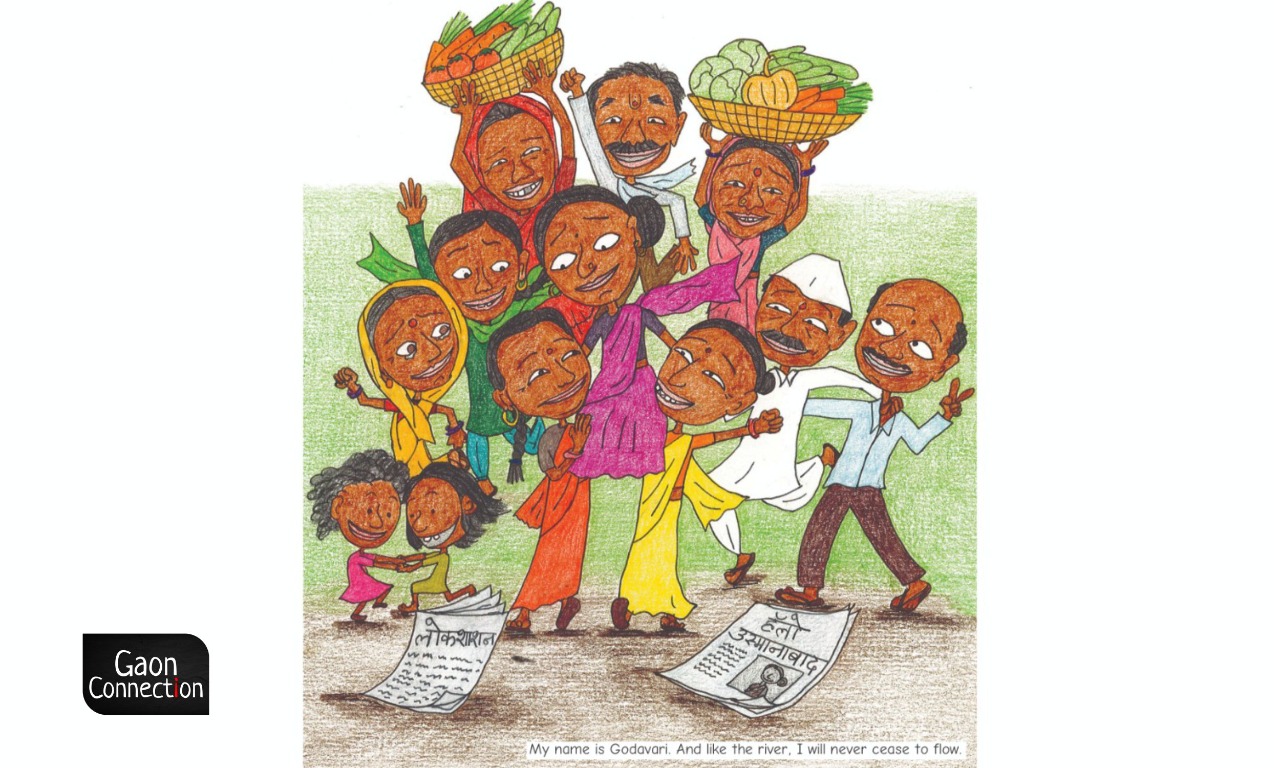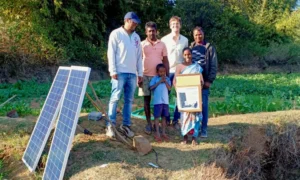Despite her phenomenal work and contribution to lifting thousands of families out of hunger and poverty in Marathwada region of Maharashtra, Godavari Dange’s story remains largely untold and unheard. In the face of repeated droughts and unending hunger and despair, Godavari, a farmer from Ghandora village, Tuljapur taluka in Osmanabad district, along with other women of her village and a self help group bucked the trend and grew food crops instead of cash crops.
Godavari’s experiments with growing food crops in just an acre reaped rich dividends and now 60,000 women in drought-prone Marathwada are practising it and ensuring that their families do not go to bed hungry.
Now, Godavari’s inspiring story is told in a comic book Raindrop in the drought: Godavari Dange.
When the Movements and Moments project of Goethe Institute (Indonesia) called for contributions for a comic book created around women, or about any grassroots feminist movement from the Global South in 2020, Maitri Dore and Reetika Revathy Subramanian applied for it. They were selected from a pool of 200 applicants from the world over, and given a grant to pursue the project. Together, Dore and Subramanian brought out the comic book, Raindrop in the drought: Godavari Dange.
Also Read: A village in Bihar goes organic, transforming the lives of its women
Subramanian, who wrote the text for the comic, is a freelance journalist who is pursuing her PhD in Gender Studies at Cambridge, United Kingdom. Through her work that is anchored in intersectional feminist politics, she aims to reconcile collaborative story telling with pressing marginalised realities.
Dore, an architect, and the illustrator of Raindrop in the drought: Godavari Dange, uses illustrations to highlight the struggles of the oppressed communities in India with the focus on gender, caste and religion. She is currently pursuing a PhD in Cultural Heritage Conservation at the University of Gothenburg in Sweden.
Dore and Subramanian chose Godavari to be the protagonist of their comic, they said, because she brought about an amazing transformation in the lives of thousands of families who thanks to her now had enough food to eat.
Simple yet striking narrative
Godavari was born into a poor family in Ghandora village in Marathwada. The parched earth, a scrawny chicken, skeletons of cattle, a dried up well with women worriedly peering into it, tell you that, right on the first page, even before you have had a chance to read the text, which is spare and simple.
Godavari leads a life no different from millions of others like her in the country. She is the daughter of a village school teacher and belongs to the Gurav community. She loves school but has to drop out as she can’t travel to another village where the senior school is located. But then, she meets Kulkarni tai who will change her life in unimaginable ways.
Meanwhile, Godavari’s life goes on, and she encounters terrible tragedies and heartbreak along the way. But, she picks herself up and achieves something remarkable.
In the face of repeated droughts and unending hunger and despair, Godavari along with other women of her village and a self help group decide to do something about it. The women farmers begin to grow food crops so that they will have something to feed their families. And, drawing upon what Kulkarni tai had taught her all those years ago, Godavari with her fellow farmers begin to grow millets, pulses and leafy green vegetables in small patches of land with startling results. Her experiments with growing food crops in just an acre reap rich dividends and soon, the one-acre model becomes the talk of Marathwada.
The six women, including Godavari, who began the experiment to keep starvation at bay and stay afloat in the face of repeated droughts, now became influencers for women farmers elsewhere.
Also Read: Using indigenous seeds to sustain livelihoods, fight climate change and pay off loans
The one-acre model gathered strength and there are 60,000 women practising it and ensuring that their families do not go to bed hungry.
The real lives
Each page in the comic gives the readers a glimpse into Godavari’s life. At the same time it is a commentary on what is the reality of thousands of women in rural Marathwada, and indeed in the country. The illustrations and text make no effort to hide the struggles and the darkness, yet the can-do attitude of Godavari and her companions wins the day.
“The narration constantly zooms in and out across scales so as to capture the enormity of her own personal tragedy as well as that of Marathwada,” Subramanian told Gaon Connection.
“Our intention was to balance the text and visuals in such a way that neither dominated, or repeated the other. Wherever possible, illustrations serve the purpose of storytelling…Where more complex themes are discussed, such as the development of the one-acre model, text steps up to task. Even here, we have tried to use short sentences and keep the text simple,” Subramanian explained.
Whatever is left unsaid, is beautifully conveyed in the illustrations. Subramanian and Dore work seamlessly, one taking up where the other leaves off.
Illustrating for the comic was a challenge, said Dore, who first hand drew each illustration. “To have to conceptualise the story at both the scale of the entire book, as well as of the individual panels… meant not getting sucked into making the individual panels too detailed or having them deliver the entire message, because each needed to be one piece in the bigger picture,” Dore, told Gaon Connection.
Also Read: Tribal women from Koraput make a clean sweep with traditional brooms
“It was really important to use all the material we got from Godavari… and this applied to the visuals as well. We were telling the story from her perspective and it needed to be relatable,” Dore explained. So every last detail like how Godavari tied her hair, what kind of a home she lived in and so on, were mined from the tonnes of photographs of her she and Subramanian took along with some old photos Godavari shared with them.
At every stage of creating the comic, they shared the text and illustrations with Godavari to get her feedback.
“It is immensely fulfilling that the comic has now taken on a life of its own. It has caught the attention of the local district collector and will be circulated in the government-run schools in Osmanabad district. Godavari has also shared the book with the other women farmers (including her mother), many of whom are illiterate,” Subramanian said. She and Dore hope that the comic format continues to transcend linguistic barriers, and Godavari’s story reaches everyone.
Read the comic ‘Raindrop in the drought: Godavari Dange’ here.



















